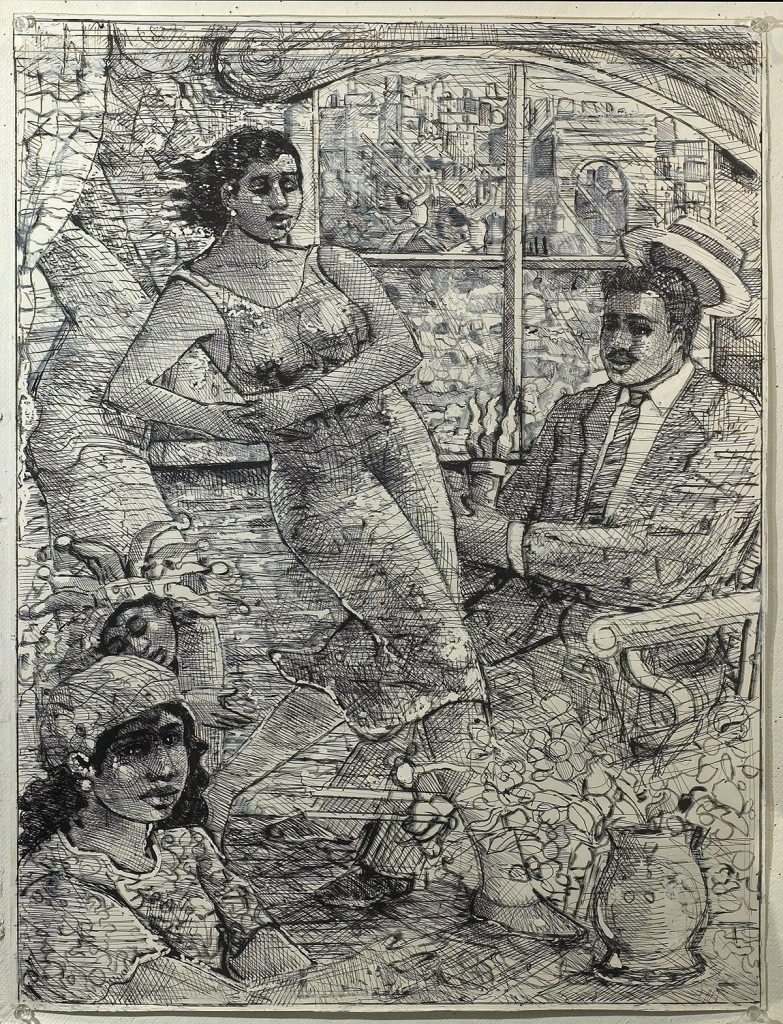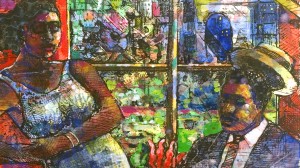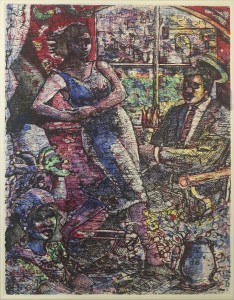Room Opens Onto NYU’s Neighborhood
 Several years ago, while in residence at the Faculty Resource Network at New York University, Louis Delsarte, inspired by the university’s symbol of the torch as a metaphor for knowledge as light, and education as the means to banish darkness, created “The Light.“ This composition uses imagery to convey specific concepts. For example, the window at the back of the room that opens onto a view of Washington Square Park and its iconic arch provides a window to the neighborhood. The graceful woman pictured in this composition symbolizes vitality, joy, and the fluidity of life, dancing in front of the seated man who anchors the composition and represents the idea of permanence. This combination evokes the eternal interplay between the new and changing elements and established truths that are perceived as unchanging. Behind the dancing woman hangs a harlequin who is the “fool.” He reminds us that life and its absurdities exist in dialogue with wisdom and rationality. In the picture’s margin, another barely visible woman is glimpsed reading, a principal activity of university communities. Lest all of this appear too somber, Delsarte has included numerous lighter details, such as flowers, that exemplify both decoration and levity.
Several years ago, while in residence at the Faculty Resource Network at New York University, Louis Delsarte, inspired by the university’s symbol of the torch as a metaphor for knowledge as light, and education as the means to banish darkness, created “The Light.“ This composition uses imagery to convey specific concepts. For example, the window at the back of the room that opens onto a view of Washington Square Park and its iconic arch provides a window to the neighborhood. The graceful woman pictured in this composition symbolizes vitality, joy, and the fluidity of life, dancing in front of the seated man who anchors the composition and represents the idea of permanence. This combination evokes the eternal interplay between the new and changing elements and established truths that are perceived as unchanging. Behind the dancing woman hangs a harlequin who is the “fool.” He reminds us that life and its absurdities exist in dialogue with wisdom and rationality. In the picture’s margin, another barely visible woman is glimpsed reading, a principal activity of university communities. Lest all of this appear too somber, Delsarte has included numerous lighter details, such as flowers, that exemplify both decoration and levity.
Riff on a Standard Tune
 Using “The Light”, Delsarte has created a suite of prints that use the aforementioned composition in many highly inventive ways. As a result, his suite becomes an extended improvisation interpreted through light and color. As a jazzman might continuously riff on a standard tune, each time changing its emotional impact, Delsarte has used light and color to reconfigure the composition, each time giving it fresh nuances that shift in mood and emotion. These variations demand constant recalibration of the scene by the viewer as both figures and the room itself appear to be washed in changing colors as if lighted through a stained glass filter. Sometimes warm, sometimes cool, reds, blues, greens and other colors spill over the forms pushing them alternately toward abstraction or sensual naturalistic contours. The banquet of color almost overwhelms the prints infusing them with feeling and often a sense of mystery. Delsarte has used light and color to reconfigure the composition, each time giving it fresh nuances that shift in mood and emotion. These variations demand constant recalibration of the scene by the viewer as both figures and the room itself appear to be washed in changing colors as if lighted through a stained glass filter. Sometimes warm, sometimes cool, reds, blues, greens and other colors spill over the forms pushing them alternately toward abstraction or sensual naturalistic contours. The banquet of color almost overwhelms the prints infusing them with feeling and often a sense of mystery.
Using “The Light”, Delsarte has created a suite of prints that use the aforementioned composition in many highly inventive ways. As a result, his suite becomes an extended improvisation interpreted through light and color. As a jazzman might continuously riff on a standard tune, each time changing its emotional impact, Delsarte has used light and color to reconfigure the composition, each time giving it fresh nuances that shift in mood and emotion. These variations demand constant recalibration of the scene by the viewer as both figures and the room itself appear to be washed in changing colors as if lighted through a stained glass filter. Sometimes warm, sometimes cool, reds, blues, greens and other colors spill over the forms pushing them alternately toward abstraction or sensual naturalistic contours. The banquet of color almost overwhelms the prints infusing them with feeling and often a sense of mystery. Delsarte has used light and color to reconfigure the composition, each time giving it fresh nuances that shift in mood and emotion. These variations demand constant recalibration of the scene by the viewer as both figures and the room itself appear to be washed in changing colors as if lighted through a stained glass filter. Sometimes warm, sometimes cool, reds, blues, greens and other colors spill over the forms pushing them alternately toward abstraction or sensual naturalistic contours. The banquet of color almost overwhelms the prints infusing them with feeling and often a sense of mystery.
The Excellence of the Drawing
 Though most prints in the suite of “The Light” are hand-colored, some trace the transition of the print from its initial graphic design through monochromatic stages in anticipation of its fully polychromatic expression. In the initial design that is without color, the excellence of the drawing and composition are evident and the descriptive content is apparent. Black and white proofs provide the purest statement of the underlying imagery that structures the print. They set forth shapes over which Delsarte freely plays with color and light. His play involves several experiments in which form has been rendered more abstractly. The great value of these prints is that they show the creative mind of the artist, and they capture his openness to experimentation.
Though most prints in the suite of “The Light” are hand-colored, some trace the transition of the print from its initial graphic design through monochromatic stages in anticipation of its fully polychromatic expression. In the initial design that is without color, the excellence of the drawing and composition are evident and the descriptive content is apparent. Black and white proofs provide the purest statement of the underlying imagery that structures the print. They set forth shapes over which Delsarte freely plays with color and light. His play involves several experiments in which form has been rendered more abstractly. The great value of these prints is that they show the creative mind of the artist, and they capture his openness to experimentation.
African Musical Traditions
 Delsarte’s “The Light” is a testament to the power of his imagination to reinvent and visualize a single idea in multiple ways that are both fascinating and provocative. His love of improvisation with color and light allies strongly with African musical traditions that have strongly impacted all areas of the arts in which black Americans have engaged. It is in this sense that “The Light” recalls jazz, for as musical tones capture and toy with our passions, so do color and light evoke moods that shift our understanding and appreciation of images before us. In the spirit of embracing experimentation and improvisation, Delsarte sweeps us along with his series “The Light”.
Delsarte’s “The Light” is a testament to the power of his imagination to reinvent and visualize a single idea in multiple ways that are both fascinating and provocative. His love of improvisation with color and light allies strongly with African musical traditions that have strongly impacted all areas of the arts in which black Americans have engaged. It is in this sense that “The Light” recalls jazz, for as musical tones capture and toy with our passions, so do color and light evoke moods that shift our understanding and appreciation of images before us. In the spirit of embracing experimentation and improvisation, Delsarte sweeps us along with his series “The Light”.
Learn more about the author of this article: Edmund Barry Gaither
